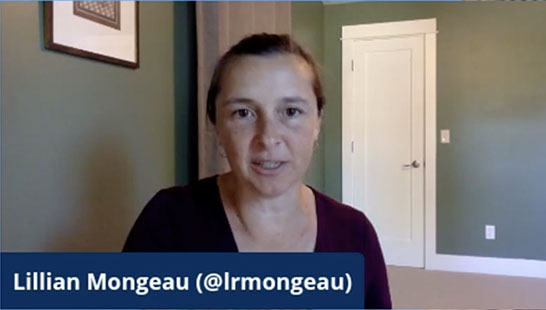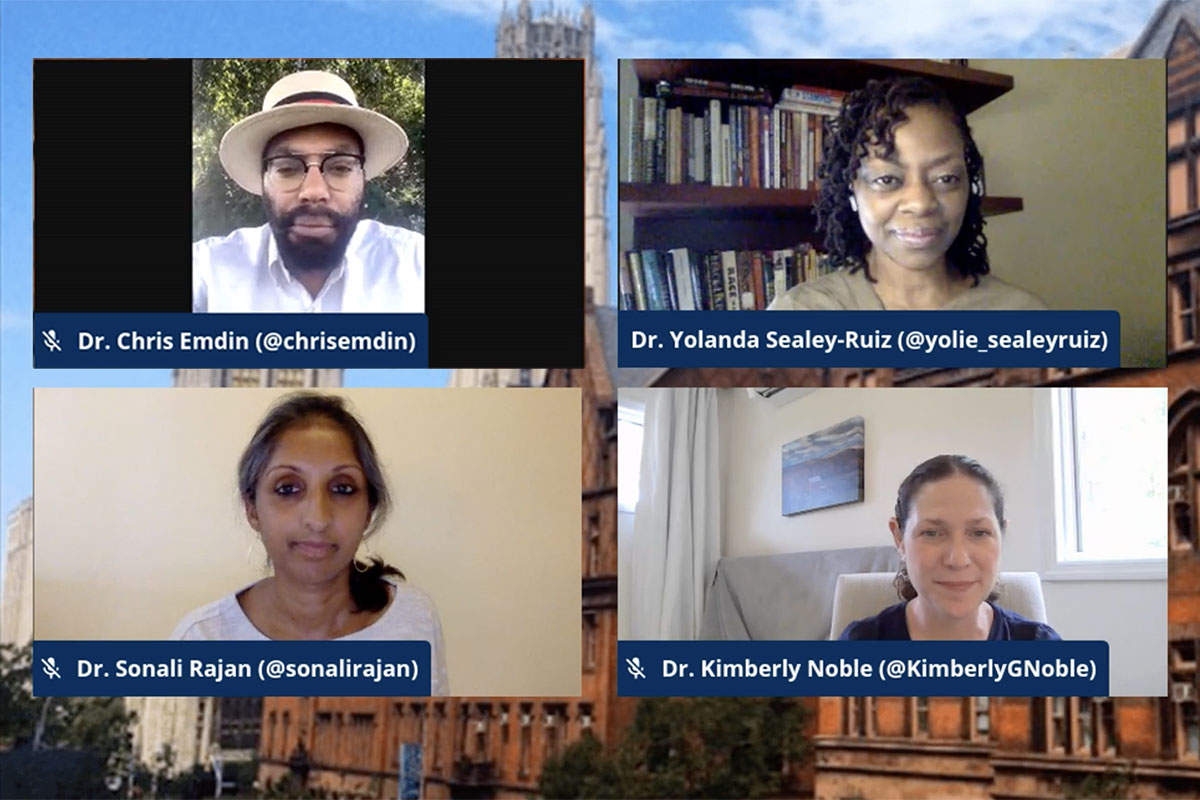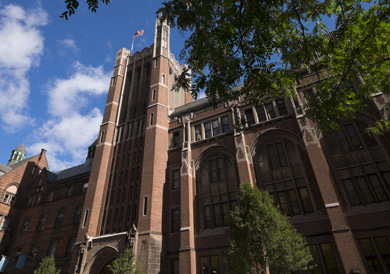The introduction that this year’s incoming students are getting to Teachers College is far from business as usual. Nearly all their coursework is online, the dining hall and library are still off limits, and faculty and classmates are, for the most part, just faces on a laptop screen.
But during a day of discussions titled “The Causes and Consequences of Inequality,” streamed to admitted students as part of the College’s first-ever virtual orientation, there could be no mistaking TC’s ongoing focus on issues of equity and social justice.
360º The Causes and Consequences of Inequality
The views expressed in this video are solely those of the speaker to whom they are attributed. They do not necessarily reflect the views of the faculty, administration, staff or Trustees either of Teachers College or of Columbia University.
In a 45-minute conversation devoted to what TC President Thomas Bailey called the “core tenet of our work,” four faculty members — Christopher Emdin, Associate Professor of Science Education; Kimberly Noble, Professor of Neuroscience & Education; Sonali Rajan, Associate Professor of Health Education; and Yolanda Sealey-Ruiz, Associate Professor of English Education — detailed the research and projects they have launched in “the pursuit of a more equitable world and eradication of disparities that disproportionately affect so many in our society.”
The four were introduced by Sonya Douglass Horsford, Associate Professor of Education Leadership, who said that the event exemplified the College’s “vibrant intellectual commitment to inequality, whether it is the racial opportunity gap, health disparities or the social-emotional inequities that impact the way children learn.” And Noble added that “the fact that we all come from different disciplines and are able to have this conversation is incredible. It speaks to full engagement, even virtually.”
A complete understanding of homophobia, racism and privilege, Sealey-Ruiz said, “is a human endeavor that requires of folks who go into teaching to ask themselves, ‘What is blocking me from being fully human in front of my students?’ And, ‘What causes me to see my students as other than fully human?’”
A case in point, said Emdin, was Baby’s First Years, the landmark study, co-directed by Noble, of the social, emotional and cognitive outcomes generated by providing cash stipends to low-income mothers over the first three years of their infants’ lives.
By allowing society “to see Black and Brown babies through the lens of their inherent genius,” Emdin said, the $15 million, multi-site study dovetails with his own groundbreaking efforts to use hip hop as a means of engaging students of color in science, as well as with Rajan’s ongoing deep dive into the causes and prevention of gun violence.
Rajan, who is working with Columbia’s Mailman School of Public Health to identify models that can deter violence without disproportionately punishing youth of color — “particularly Black and Brown boys” — asserted that “gun violence is not an emerging threat,” but has instead been a reality “for decades,” in no small part due to the absence of “creative and evidence-born solutions to save children.”
Rajan said that “gun violence is not an emerging threat,” but has instead been a reality “for decades,” in no small part due to the absence of “creative and evidence-born solutions to save children.”
Sealey-Ruiz meanwhile drew on the compass that guides her teaching, writing and outlook on life.
The amelioration of inequity, said Sealey-Ruiz, is contingent on “the archaeology of the self and a deep sense of self-excavation” that fall beyond the traditional boundaries of pedagogy and professional development. A complete understanding of homophobia, racism and privilege, she said, “is a human endeavor that requires of folks who go into teaching to ask themselves, ‘What is blocking me from being fully human in front of my students?’ And, ‘What causes me to see my students as other than fully human?’”
Inequality will prevail, Sealey-Ruiz warned, until “we reframe the questions, reframe the thinking and start with the self.”

Lillian Mongeau, Senior Editor for The Hechinger Report. (Photo: TC Archives)
In essence, the event’s moderator — Lillian Mongeau, Senior Editor for The Hechinger Report — did just that by asking each panelist to share an experience that guided them toward the pursuit of equity. The anecdotes, poignant and telling, were as varied as the speakers' respective academic pursuits.
At the STEM-specialized high school he attended, Emdin had “access to a foundry, we got to do hands-on projects and had to pick a ‘major’ by 10th grade. And then I’d go home to a place with young folks who looked just like me, who were just as smart as me, but who weren’t having the same experiences because they didn’t know about or didn’t take the test.”
Rajan described a 16-week teaching mentorship she experienced in a rural Ithaca, New York, school district during her final undergraduate semester at Cornell University.
“It was my first time seeing what inequality and lack of resources in public schools looks like,” she said.
Sealey-Ruiz recalled growing up in the South Bronx during the turbulent 1970s.
“We were talked about horribly in the media,” she said. “The movie Bonfire of the Vanities made it look like we were living in a war zone. I knew there was something unfair about the way my community was represented. I didn’t have the language then. But as I grew older and became a researcher, I realized my community was underfunded in multiple ways because of deep racism toward people who look like me.”
Noble shared the memory of the summer she volunteered at a summer camp serving children from a Philadelphia housing project.
“It was the first moment I remember recognizing my white privilege,” she said. A teenager she spoke with who wanted to become a lawyer “didn’t know anything about taking the SAT or applying for college. And I reflected that that kind of information had been handed to me and was expected of me. There was never a question that I would go to college – it was a pre-determined path. I grew up in that environment. But no one had given this girl with these expectations the pathway to get there.”
A teenager Noble once spoke with who wanted to become a lawyer “didn’t know anything about taking the SAT or applying for college. And I reflected that that kind of information had been handed to me and was expected of me. There was never a question that I would go to college – it was a pre-determined path. I grew up in that environment. But no one had given this girl with these expectations the pathway to get there.”
The journey for Emdin began with acing a test that led to his admission to Brooklyn Technical High School, an elite New York City public magnet high school that specializes in science, technology, engineering, and mathematics.
“I got to travel to Brooklyn everyday while the friends that I grew up with in the Bronx stayed home,” he recalled.
Brooklyn Tech students had “access to a foundry, we got to do hands-on projects and had to pick a ‘major’ by 10th grade. And then I’d go home to a place with young folks who looked just like me, who were just as smart as me, but who weren’t having the same experiences because they didn’t know about or didn’t take the test.”

